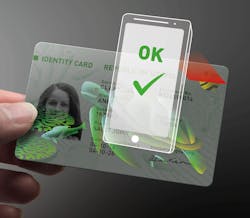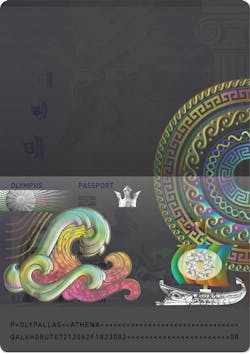Security is a constant challenge in an increasingly digital environment. Unfortunately, when checking security features, ensuring authenticity and verifying documents against a database entry remains tricky.
This is a challenge IQ Structures (Husinec, Czech Republic), a research and production organization focused on nanotechnology engineering, is aiming to solve with an app using technology already equipped in most mobile phones. IQ Structures’ approach works by illuminating the hologram, reading it with the phone, and enabling the app to confirm authenticity.
“Machine-readable holograms combine two very powerful principles. Our holograms contain unique visual effects that virtually cannot be replicated because they are based on special nanostructures. The second principle is automated control, immune to human failure. Each is powerful, together it is unbreakable,” says IQ Structures CEO Petr Franc. “Our new technology has a range of applications, from personal documents to paper certificates and brand protection.”
The machine-readable holograms are put into ID documents as part of IQ proID’s product. This product is based on microsegmentation technology to ensure seamless integration into the card. Any attempt to manipulate the holographic layer ends up disintegrating the hologram into thousands of miniature parts.There’s a specific optical security feature integrated in the physical identity documents (ID card, driver’s license, passport data page). It carries distinctive visual effects which cannot be copied or imitated. “Whenever there is a demand for the identity check, the physical document is scanned by the mobile app and authenticated using the visual behavioral analysis of the diffraction optics-based effects,” says Robert Dvorak, managing director of IQ Structures. “The system is tuned for fast in situ reading; there’s no other equipment needed for unambiguous authentication of the holder’s identity. After such identity verification, a digital version of the identity is generated.”
Road ahead
The key to achieving commercial success? Attracting all stakeholders (governmental bodies and agencies) to integrate the solution in the authentication processes, explains Dvorak.
“Further developments are focused on the digital identity on-boarding services provided globally,” says Dvorak. “Establishing a hybrid identity, such as a physical document carrying the holder´s identity data connected with its digital alter ego, seems to be the right technology for the upcoming years.”
Machine-readable holograms open the door to a wide array of protective powers. For instance, Dvorak foresees machine-readable holograms assisting with brand protection. The holograms currently provide companies with track-and-trace capabilities. However, customers rarely know the details. Instead, the presence of a hologram provides peace of mind. With machine-readable technology, a customer could use the app to check that the hologram is a genuine security feature.

Peter Fretty | Market Leader, Digital Infrastructure
Peter Fretty began his role as the Market Leader, Digital Infrastructure in September 2024. He also serves as Group Editorial Director for Laser Focus World and Vision Systems Design, and previously served as Editor in Chief of Laser Focus World from October 2021 to June 2023. Prior to that, he was Technology Editor for IndustryWeek for two years.
As a highly experienced journalist, he has regularly covered advances in manufacturing, information technology, and software. He has written thousands of feature articles, cover stories, and white papers for an assortment of trade journals, business publications, and consumer magazines.

